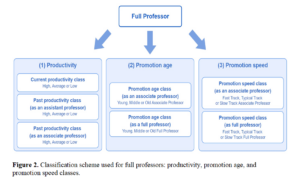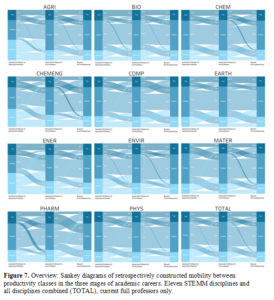Marek Kwiek had a presentation at SRHE Annual Conference 2022 (Society for Research into Higher Education) on December 8, 2022.
He was talking about:
„Quantifying Academic Careers: Large-Scale Data and Changing Individual Research Productivity from a Longitudinal Perspective”
This study explores persistence in research productivity at the individual level over time. We examine the trajectories of the academic careers of 2,326 current full professors, including their lifetime biographical histories and their lifetime publication histories. We studied the dates of their academic promotions and their publication output between promotions over a 40-year period across 14 science, technology, engineering, mathematics, and medicine (STEMM) disciplines. Our focus is not on productivity per se but on transitions between productivity classes throughout the professors’ academic careers, from the assistant professor stage to the full professor stage.
We used a com bination of administrative, biographical, and bibliometric data. It was not possible to perform lifetime retrospective analyses of individual scientists without having full access to raw bibliometric metadata for all publications by all individual scientists in the past 40 years. It was not possible to construct retrospective productivity classes for all scientists by discipline, career stage, and selected period without having access to each scientist’s global publication metadata.
Our six hypotheses pertain to: persistence of high productivity (H1) and low productivity (H2) over time; and persistence of high productivity at the beginning and towards the end of academic careers (H4); as well as disciplinary differentiation (H3) and gender differentiation (H5) in mobility between productivity classes, and individual vs. organizational features (H6) in logistic regression analysis estimating odds ratio of belonging to top and bottom productivity classes. An overaching research question is about changes in productivity from a life-cycle perspective: have current top performing full professors always been top performing while current low performing full professors – always low performing?
In this study, we applied the notion of climbing the academic ladder, which defines an academic career that spans several decades. Current full professors have previously been first assistant professors and then associate professors. They remained for a specific number of years at each stage of their academic careers. In each stage, they demonstrated specific productivity—that is, a certain number of publications in a four-year reference period. We assigned seven academic career classes to each full professor (Figure 1).

Figure 1. Classification scheme used for full professors: productivity, promotion age, and promotion speed classes.
The majority of highly productive scientists (Top) remained highly productive compared with their peers in the same discipline and within the same academic position, which is shown in thick left-to-right horizontal flows (Figure 2). More than half of the highly productive scientists moved from the top class to the top class in the first (52.6%) and second stages of their academic careers (50.8%). Patterns are similar across STEMM fields (Figure 3).
We also examined odds ratio estimates of belonging to top and bottom productivity classes for current full professors and, retrospectively, for them at earlier stages of their academic careers to belong to these two classes. The results of our logistic regression models supported previous findings that professors appointed early tended to be more productive than professors appointed later in their careers (Abramo et al. 2016). Membership in the class of young full professors increased the odds of belonging to the class of highly productive scientists by an average of 94.2%. Interestingly, in the Polish context, neither gender nor age (biological or academic) emerged as a predictor of membership in the class of highly productive full professors.
The results of this study supported all six hypotheses. They also supported the “sacred spark” theory of productivity (Cole & Cole 1973; Stephan & Levin 1992). Some scientists are superb at doing science from the moment they enter the academic workforce to their late career stages. About half of the highly productive full professors had always been highly productive, regardless of the trajectories of their personal lives or their external circumstances (e.g., the post-communist transition period in the Polish economy, which severely affected the academic sector). Highly productive full professors in their 60s were also highly productive when they were assistant and associate professors in their 30s, 40s, and 50s.
The patterns of mobility between productivity classes over the course of an entire academic career may have far-reaching implications for hiring and promotion. Hiring and tenure to both low-productivity and high-productivity scientists may have long-standing consequences for institutions and the national system. After entering the system and achieving job stability, scientists in Poland (where attrition is very low) and elsewhere usually remain in the system for years, if not decades.


We also examined odds ratio estimates of belonging to top and bottom productivity classes for current full professors and, retrospectively, for them at earlier stages of their academic careers to belong to these two classes. The results of our logistic regression models supported previous findings that professors appointed early tended to be more productive than professors appointed later in their careers (Abramo et al. 2016). Membership in the class of young full professors increased the odds of belonging to the class of highly productive scientists by an average of 94.2%. Interestingly, in the Polish context, neither gender nor age (biological or academic) emerged as a predictor of membership in the class of highly productive full professors.
The results of this study supported all six hypotheses. They also supported the “sacred spark” theory of productivity (Cole & Cole 1973; Stephan & Levin 1992). Some scientists are superb at doing science from the moment they enter the academic workforce to their late career stages. About half of the highly productive full professors had always been highly productive, regardless of the trajectories of their personal lives or their external circumstances (e.g., the post-communist transition period in the Polish economy, which severely affected the academic sector). Highly productive full professors in their 60s were also highly productive when they were assistant and associate professors in their 30s, 40s, and 50s.
The patterns of mobility between productivity classes over the course of an entire academic career may have far-reaching implications for hiring and promotion. Hiring and tenure to both low-productivity and high-productivity scientists may have long-standing consequences for institutions and the national system. After entering the system and achieving job stability, scientists in Poland (where attrition is very low) and elsewhere usually remain in the system for years, if not decades.
References
Abramo, G., D’Angelo, C. A., & Murgia, G. (2016). The combined effects of age and seniority on research performance of full professors. Science and Public Policy, 43(3), 301–319.
Fox, M. F. (2020). Gender, science, and academic rank: Key issues and approaches. Quantitative Science Studies, 1(3), 1001–1006.
Fox, M. F., & Nikivincze, I. (2021). Being highly prolific in academic science: Characteristics of individuals and their departments. Higher Education, 81, 1237–1255.
Heckman, J. J., & Moktan, S. (2018). Publishing and promotion in economics. The tyranny of the top five. NBER Working Paper 25093.
Kwiek, M. (2015). Academic generations and academic work: Patterns of attitudes, behaviors and research productivity of Polish academics after 1989. Studies in Higher Education, 40(8), 1354–1376.
Kwiek, M. (2019). Changing European academics. A comparative study of social stratification, work patterns and research productivity. London and New York: Routledge.
Kwiek, M., & Roszka, W. (2021a). Gender disparities in international research collaboration: A large-scale bibliometric study of 25,000 university professors. Journal of Economic Surveys. Vol. 35(5), 1344-1388. doi: 10.1111/joes.12395
Kwiek, M., Roszka, W. (2021b). Gender-based homophily in research: A large-scale study of man-woman collaboration. Journal of Informetrics, 15(3), article 101171. 1–38.
Kyvik, S. (1990). Age and scientific productivity: Differences between fields of learning. Higher Education, 19(1), 37–55.
Levin, S., & Stephan, P. E. (1991). Research productivity over the life cycle: Evidence for academic scientists. The American Economic Review, March, 114–132.
Lutter, M., & Schröder, M. (2016). Who becomes a tenured professor, and why? Panel data evidence from German sociology, 1980–2013. Research Policy, 45(5), 999–1013.
Marini, G., & Meschitti, V. (2018). The trench warfare of gender discrimination: Evidence from academic promotions to full professor in Italy. Scientometrics, 115(2), 989–1006.
Merton, R. K. (1968). The Matthew effect in science. Science, 159(3810), 56–63.
Mihaljević-Brandt, H., Santamaría, L., & Tullney, M. (2016). The effect of gender in the publication patterns in mathematics. PLOS ONE, 11(10), e0165367.
Savage, W. E., & Olejniczak, A. J. (2021). Do senior faculty members produce fewer research publications than their younger colleagues? Evidence from Ph.D. granting institutions in the United States. Scientometrics 126, 4659–4686
Stephan, P. (2012). How economics shapes science. Cambridge, MA: Harvard University Press.
Stephan, P. E., & Levin, S. G. (1992). Striking the mother lode in science: The importance of age, place, and time. New York: Oxford University Press.
Sugimoto, C., & Larivière, V. (2018). Measuring research: What everyone needs to know. Oxford: Oxford University Press.
Wang, D., & Barabási, A. (2021). The science of science. Cambridge: Cambridge University Press.
Yuret, T. (2018). Path to success: An analysis of US educated elite academics in the United States. Scientometrics, 117, 105–121.


